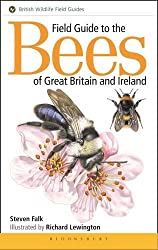A National Strategy For Pollinators
If I could have my own way, and if I could persuade the political parties of my country to let me write it, what would a National Strategy For Pollinators look like?
In the UK, as I write there is much lively political debate, with competing parties having had conferences, and some with manifestos on the table.
Wildlife specific
policy scarcely gets a look in, but this doesn’t mean we should stop talking about
and insisting on the need to protect bees, pollinators, and indeed
invertebrates generally.
In the UK, policy manifestos are short summaries, with perhaps one or two sentences to explain each point. So, if I were to write a national pollinator strategy - i.e. an outline of what we should do to protect bees and other pollinators, it might look something like this:
National Strategy For Pollinators
Background
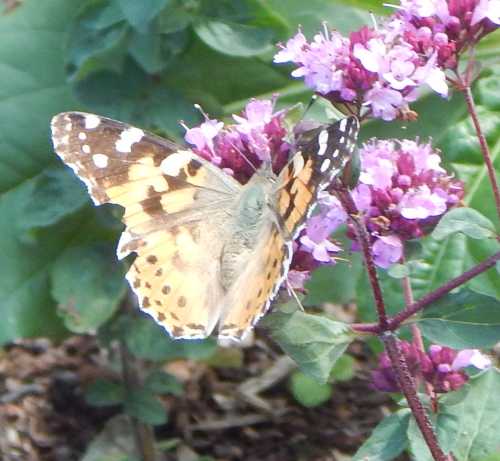 Painted lady butterfly on oregano.
Painted lady butterfly on oregano.According to evidence presented by the UK Environment Audit Committee investigation, Pollinators and Pesticides, two thirds to three quarters of Britain’s pollinator species are declining, yet wild pollinators conduct 90% of pollination in the UK. It is therefore imperative to food security, the wider environment, horticulturists, and gardeners, for action to be taken to safeguard pollinators.
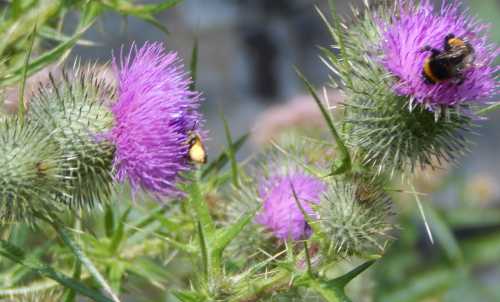 Bees on thistles.
Bees on thistles.Key Elements Of A National Pollinator Strategy:
1. Joined Up Thinking On Pollinator Corridors And Habitat
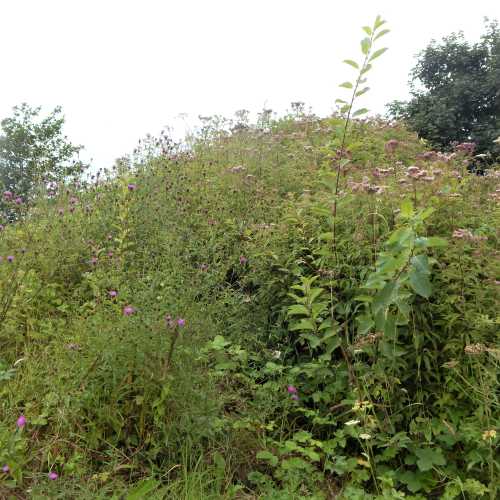 Wild verge and paradise for pollinators: knapweed, hemp agrimony, thistle, bramble, daisies, wild rose and more occupy this space.
Wild verge and paradise for pollinators: knapweed, hemp agrimony, thistle, bramble, daisies, wild rose and more occupy this space.- Create more wildflower corridors for pollinators. Adopt mowing and planting regimes to support pollinators, on local and national road verges, as well as waterway banks (canals, rivers) where feasible, and where safety permits. The creation of pollinator verges is a cost effective method of creating wildflower habitat for a variety of pollinator and invertebrate species.
- Local councils should be encouraged to use pollinator-friendly plants as part of their formal and public planting schemes.
- The
use of pesticides in public places and along Pollinator Corridors should be
abolished.
2. Farmland Pollinator Strips
Ensure farmer incentive and benefit schemes are contingent upon the creation of
pollinator habitats. Farmland pollinator
margins and hedgerows are beneficial to farmers and pollinators, and their
creation should be encouraged.
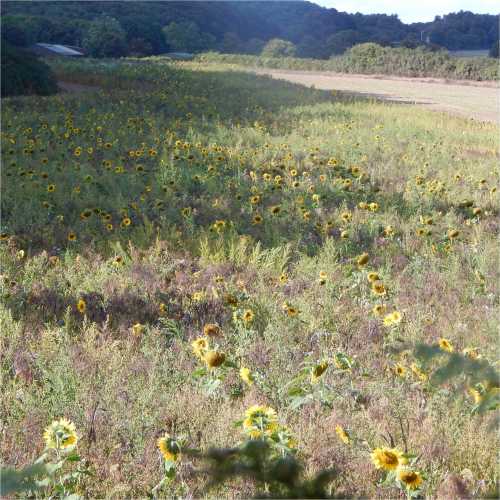 Pollinator margin in Norfolk, England, late autumn.
Pollinator margin in Norfolk, England, late autumn.3. Commercial Sale of Bumble Bees
Some bumble bee species are available to growers for use in poly tunnels, as well as the general public for use in their gardens. These are native species, but reared overseas.
Despite efforts to control for disease by public bodies, independent research suggests there may be a risk to wild bumble bee species from commercially reared specimens (1).
- Commercially reared bumblebees should be banned from sale to the public.
- (I
am inclined to state that commercially reared bumble bees should be banned from use
in commercial greenhouses, although I understand this could seriously
compromise food crops. I would therefore
propose that suppliers of bees to growers are required to undertake urgent measures to
address the risks of spreading disease (such as sterilizing the pollen fed to
bumble bee larvae at the time of rearing), as well as more diligent screening by
the relevant UK authorities. In the
meantime, growers need to be educated regarding the risks to wild species, and
we need to find out whether growers can take additional steps to prevent
contamination of wild bees.
4. Protection For Nesting Bees In Urban And Residential Settings
Bumble bee nests are temporary, and bumble bee species face particular challenges. Yet nests are often destroyed by members of the public, quite unnecessarily, and through ignorance. There are many ways to minimise possible contact with bumble bees from nearby nests, and the risks of serious injury through stinging by bumble bees are very minimal.
- I believe that bumble bee nests should be protected. Given
that bumble bee nests only last a few weeks, the destruction of bumble bee
nests from
homes, gardens and urban settings, should be illegal, but that
relocation
should only be allowed in particular circumstances by recognised bodies
and
professionals (perhaps having first been assessed by a trained,
independent representative from a wildlife organisation?) and when there
is very real need or risk of harm (for instance, unstable
buildings, or rare, but fatal allergy). Protection
of nesting species is not unusual in the UK, and precedence has already
been
set, for example, with regard to bats.
- Protection for solitary bee nests.
- Honey
bee swarms and nests to be moved by beekeepers registered with the local
council. There could be some form of
compensation scheme for a beekeeper incurring any expenses, or better still,
why not have a resident beekeeper whose job it is to re-home the bees, and care
for them temporarily where necessary.
5. Monitoring Of Species
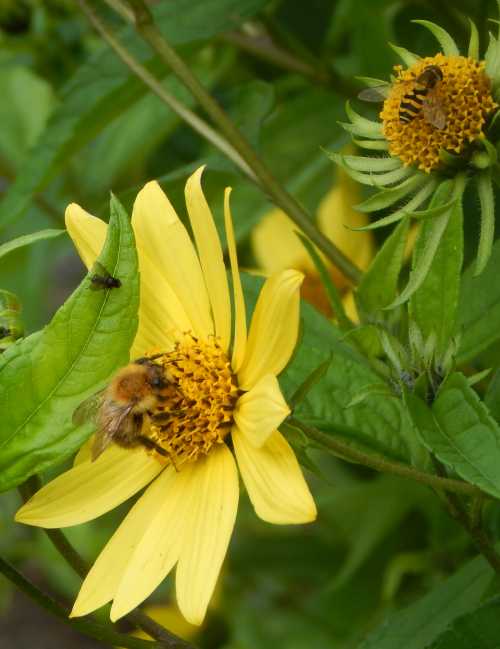 Flies and bumble bee on Helenium.
Flies and bumble bee on Helenium.Monitoring of species abundance enables us to understand our impact on the environment, which in turn can help inform legislation, and support given to farm owners and land managers.
Therefore, we should have formal, standardized and regular monitoring, and possibly contracted out to universities.
6. Independent Information For Farmers
Research
indicates that farmers may use insecticides quite unnecessarily. For example, a study by ADAS (2) clearly
indicated that between 1988 and 2006, the threat of pollen beetle did not
warrant chemical use by farmers, yet farmers very significantly over-used insecticides
(at no doubt, significant cost).
With articles in the farming press by the
agro-chemical industry, pushing the notion that there is a threat of pollen
beetle, and agronomists being paid commissions for selling pesticides, it’s
clear farmers need access to accurate, timely and independent information.
I would also suggest that the agro-chemical industry needs to be regulated so that the promotion (however subtle) of pesticides use by the misrepresentation of a 'pest threat', is illegal.
7. Pesticide Regulation And Public Confidence
Noting the controversial move of Government (Defra) civil servants (such as Fera’s Helen Thompson, CRD’s Peter Campbell) to industry employment, we should take action to restore trust in regulators and influential government bodies.
We should seek ways to minimise undue influence of industry on government employees to ensure that decisions by public servants are not seen to be motivated by personal gain, including employment in the private sector(3).
For example, this may be achieved by extending the right of the general public to use the Civil Servant’s Code of Conduct to complain against a government employee, and by ensuring the balance of duty of civil servants is first and foremost to the public good, not to commercial interests, (and this should be reflected in the mission statements of DEFRA bodies).
Transparency is essential for public confidence.
8. Education: Schools and Public
- I'm a greate believer in inspiring the next generation to care about bees, wildlife and the environment. Support continued education on pollinators in schools.
- Encourage Councils to share and supply further Pollinator education to the public via council websites. (There is little need to re-invent the wheel here, and information could be shared across councils, with some adaptations to include specific local species if relevant).
Last but not least...........
9. Neonicotinoids And Systemic Insecticides
As a group of chemicals, Neonicotinoids and systemic insecticides have been examined by the UK Environment Audit Committee, EFSA, and in addition, an international co-operation (the IUCN) examined over 800 peer-reviewed, scientific studies(5) and published their findings in the journal Environment Science and Pollution Research.
The conclusions clearly indicate a risk to pollinators and other invertebrates, whilst some studies also suggest a risk to birds(6).
EFSA took some months in their examinations of 3 neonicotinoids Fipronil, a similar systemic insecticide, and yet given the findings, the EU ruling did not adequately address the concerns raised when considering the properties of neonicotinoids, in particular, that they remain in the soil for a very long time, and hence residues may build with successive applications; they may trespass beyond treatment zones; they can contaminate water sources; and have subtle, sub-lethal and chronic effects. Given these properties, the partial restriction limited to 2 years advocated by the EU, is inadequate.
- As part of a National Strategy For Pollinators, I believe all
neonicotinoid and systemic insecticides should be banned, and
- the current UK regulatory testing regime for agro-chemicals should be reviewed with input from independent scientists, and
- the conclusions should be open to public consultation and debate.
Refs:
(1)The Trojan hives: pollinator pathogens, imported and distributed in bumblebee colonies by Peter Graystock et al, (publ. Jul 2013, Journal of Applied Ecology)
(2)Re-evaluating thresholds for pollen beetle in oilseed rape; HGCA Project No. 2005; ADAS www.adas.co.uk
(3) Government bee scientist behind
controversial study joins pesticide firm: MP raises fears that
government agency and pesticides industry are 'too close' as Dr Helen Thompson
moves to Syngenta; The Guardian, Friday 26 July 2013
(4) Drug Regulation: History, Present and Future; Lembit Rägo, Budiono Santoso.
(5)
The Worldwide Integrated Assessment of the Impact of Systemic
Pesticides on Biodiversity and Ecosystems www.tfsp.info.
(6) Declines in insectivorous birds are
associated with high neonicotinoid concentrations; Hallmann
et al; Nature 511, 341–343 (17 July 2014) doi:10.1038/nature13531.
If you found this page helpful or interesting, I'd really be grateful if you would share it with others - if not this page, perhaps another, such as Gardening For Bees.
Thank you so much :) .
